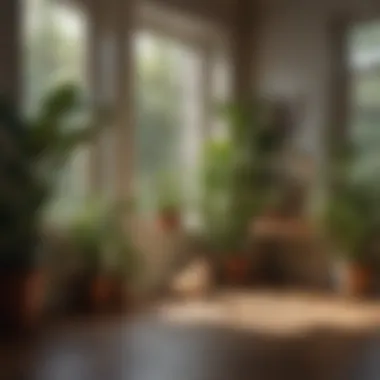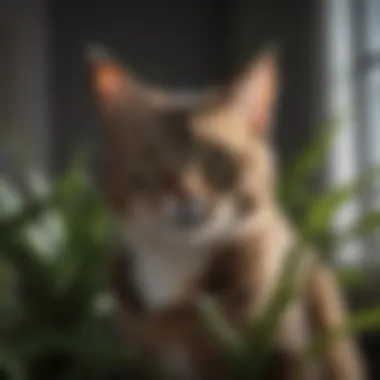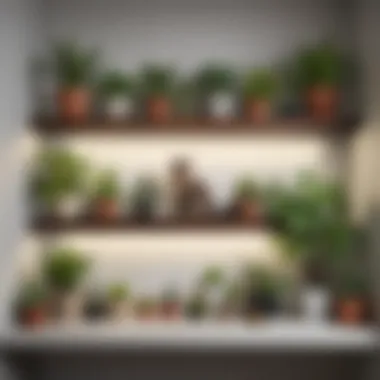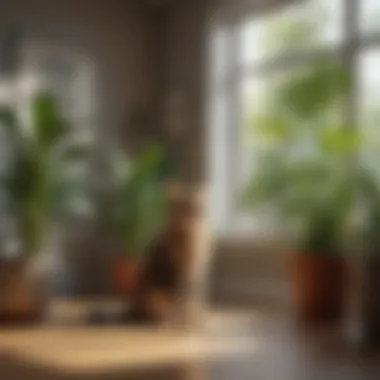Shade Loving Indoor Plants That Are Safe for Cats


Intro
Indoor plants serve multiple purposes in our homes. They enhance the aesthetic appeal and offer health benefits, such as improved air quality. However, for cat owners, the choice of plant becomes more complex. Many popular houseplants can be harmful to our feline companions. Therefore, finding the right types that thrive in low light while being safe is essential.
This guide provides comprehensive insights into shade-loving indoor plants that are friendly to cats. We will explore their unique characteristics, care requirements, and the advantages they bring to your living environment. Creating a sanctuary that caters to both greenery and your pet is achievable with the right knowledge.
Before diving into the specifics, it is crucial to dispel myths about plant toxicity. Understanding which plants offer a safe environment is paramount for responsible pet ownership. Additionally, we will offer practical tips on how to enhance the beauty of your home with these plants while ensuring the safety of your furry friends.
Understanding Shade Loving Indoor Plants
Shade loving indoor plants are a unique category that holds substantial value for both aesthetic appeal and functional roles in home environments. These plants thrive in low light conditions, making them ideal for spaces with limited natural illumination. Understanding these plants becomes crucial for housewives and homeowners who are conscious of their living conditions and want to create a serene atmosphere without compromising on plant life.
Incorporating shade loving plants can transform an indoor space. They not only enhance the beauty of the environment, but they also contribute to wellness. Such plants often purify the air and can positively affect mood and productivity. In households with cats, the importance grows. It ensures that the plants chosen coexist safely with pets, minimizing the potential for toxicity.
Moreover, one must consider the maintenance requirements of these plants. Many shade loving varieties are quite adaptable and can thrive even with less attention. This characteristic may appeal to busy individuals who still wish to enjoy greenery in their homes.
Defining Shade Loving Plants
Shade loving plants are species that exhibit a natural inclination to thrive in lower light conditions. These plants have evolved adaptations that allow them to perform photosynthesis effectively even when sunlight is limited. Common examples include the Spider Plant, Boston Fern, and Peace Lily. Understanding the distinctions between shade loving plants and those that require bright light is important.
When choosing plants for a particular area, it is vital to note that not all plants can survive in shade; thus, knowing the specific needs of shade tolerant varieties can aid in making informed decisions.
Benefits of Shade Tolerance
The benefits of shade tolerance in indoor plants extend beyond mere survival.
- Aesthetic Appeal: Unsurprisingly, the ability to plant lush greenery in dimly lit areas highlights the versatility in home decor. Plants such as the Areca Palm can bring a revitalizing touch to corners that previously felt barren.
- Air Quality Improvement: Many shade loving plants are known for their air-purifying qualities. Species like the Bamboo Palm absorb harmful toxins from the air, promoting a healthier indoor environment.
- Low Maintenance: These plants are generally more resilient, requiring less frequent watering and care compared to their light-loving counterparts.
- Stress Reduction: Studies have indicated that having plants in one’s living space can reduce stress levels and promote feelings of calm and relaxation.
- Pet Safety: For cat owners, pet-safe plants provide peace of mind. Choosing non-toxic species ensures that pet curiosity leads to no harmful consequences.
"Choosing the right plants can enhance your home's ambience without compromising on your cats' safety."
In summary, understanding shade loving indoor plants conveys significant benefits. It complements both the aesthetic and functional aspects of living spaces, providing an ideal solution for homes with limited light and feline companions.
Importance of Pet-Safe Plants
When it comes to creating a home environment, the choice of indoor plants plays a crucial role. For cat owners, selecting plants that are safe for their furry friends is essential. The importance of incorporating pet-safe plants extends beyond mere aesthetics. It reflects an awareness of potential hazards that indoor flora may pose to household pets.
Cats are naturally curious creatures, often exploring their environment through their senses, including taste. Many common indoor plants can be toxic if ingested, leading to a range of health issues from mild irritations to serious complications. Thus, opting for shade-loving plants that are safe for cats is not only a responsible choice but also a necessary consideration for their wellbeing.
Plant Toxicity and Cats
Understanding plant toxicity is vital for any pet owner. Certain houseplants, such as lilies and philodendrons, can cause substantial harm to cats upon ingestion. Symptoms of exposure might include vomiting, diarrhea, or in extreme cases, even organ failure.
- Commonly Toxic Plants for Cats:
- Lilies: Highly toxic; even small amounts can be life-threatening.
- Philodendron: Causes irritation and potential distress.
- Pothos: Can cause vomiting and oral irritation.
In this context, knowing which plants to avoid is as critical as knowing which ones are safe. This article will explore several shade-loving plants that pose no risk to cats, allowing pet owners to beautify their homes without fear of harm.
Creating a Safe Environment
Creating a harmonious environment for both plants and cats involves strategic placement and selection. The right indoor plants can enhance the aesthetic appeal of a room while ensuring safety for pets. When designing your indoor garden, consider the following recommendations:
- Careful Selection: Choose plants confirmed safe for cats, such as Spider Plants, Boston Ferns, and Areca Palms.
- Placement: Position plants in areas that are less accessible to your pets. High shelves or hanging planters can deter cats from nibbling.
- Education: Teach children and guests about the importance of not allowing cats to chew on plants, reinforcing a pet-safe atmosphere.
Top Shade Loving Indoor Plants Safe for Cats
The discussion of shade loving indoor plants safe for cats is essential for pet owners who wish to enhance their living spaces while ensuring the safety of their feline companions. These plants are not only aesthetically pleasing but also contribute to a healthier indoor environment. Choosing pet-safe plants is crucial as many common houseplants can be toxic to cats. This section will delve into several popular varieties that thrive in low-light conditions and do not present any threat to cats.
Spider Plant
Care Requirements
Spider plants are known for their resilience and adaptability. They require moderate watering, meaning the soil should remain slightly moist but never soggy. Overwatering can lead to root rot, which is a common mistake. Their ability to thrive in different conditions makes them a popular choice in homes.
One of the key characteristics of spider plants is their tolerance to neglect. They can bounce back from periods without water, making them suitable for busy households. They also prefer a well-draining potting mix to support proper root development.
Benefits in Home
In addition to being safe for cats, spider plants are excellent air purifiers. They can remove pollutants from the air, contributing to a healthier indoor atmosphere. Moreover, they have a visually appealing look, with their arching leaves adding a touch of greenery to any room.


The unique feature of spider plants is their ability to produce offshoots, which can be propagated easily. This can be a delightful activity for families, as they can share new plants with friends or keep them for future enjoyment.
Light Conditions
Spider plants prefer indirect sunlight but can adapt to various light conditions. They can survive in low light, making them suitable for darker areas of the home. However, moderate indirect light promotes better growth and vibrant foliage.
The advantage of this flexibility is that they can be placed in different rooms without worrying about light exposure. Even a corner with limited light will not hinder their growth significantly.
Boston Fern
Care Requirements
Boston ferns require consistent moisture to thrive. They need to be watered regularly, ensuring that the soil does not dry out completely. A humidity level above 50% is also recommended, making frequent misting beneficial, especially in dry conditions.
This care requirement may be a challenge for some, as neglect can lead to their leaves browning. Proper attention to humidity and watering is key, making them less suited for forgetful plant owners.
Benefits in Home
Boston ferns contribute to improved air quality by filtering toxins and promoting better humidity levels in the home. Their lush foliage provides a dramatic look, making them a stunning focal point in living areas or bathrooms.
Their unique feature is their ability to thrive in humidity, often becoming more vibrant in moisture-rich environments, such as bathrooms, where they flourish.
Light Conditions
Boston ferns prefer indirect light and may suffer if exposed to direct sunlight. They can do well in low-light locations but will require sufficient moisture to maintain their health under those conditions.
This characteristic makes them a thoughtful choice for rooms that do not receive much natural light, provided their hydration needs are met.
Bamboo Palm
Care Requirements
Bamboo palms are low-maintenance plants that thrive under careful watering. They prefer their soil to dry out slightly between watering sessions. Hence, allowing the top inch of potting mix to dry out is beneficial.
The main characteristic of bamboo palms is their resilience. They can tolerate neglect without losing their robust nature, which makes them a favorite among houseplant enthusiasts.
Benefits in Home
Bamboo palms are well-known for their air-purifying qualities. They actively remove indoor toxins, creating a cleaner environment for both people and pets. Their elegant, tall appearance makes them a great addition to corners or entryways.
A unique feature of bamboo palms is their ability to grow well in containers, allowing them to fit into various living spaces easily. This flexibility is a significant advantage for smaller homes.
Light Conditions
Bamboo palms thrive in indirect light, which makes them perfect for homes with limited sunlight. They can adapt to low-light conditions but might grow slower under these circumstances.
Their adaptability to different lighting means they can be placed in various spots around the home without fear of compromising their health.
Areca Palm
Care Requirements
Areca palms thrive in bright, indirect sunlight and prefer humid environments. They benefit from regular watering, which keeps their soil moist but not soggy. This makes them ideal for the family that enjoys maintaining a vibrant green space.
The key characteristic of Areca palms is their fast growth and slender leaves, providing a tropical feel to indoor spaces. If they start to lose their leaves, it can be an early sign that their watering needs are not being met.
Benefits in Home
Areca palms are excellent for improving indoor air quality. They effectively filter out harmful gases, creating a healthier environment. Their lush appearance can also add a tropical flair, making spaces feel more inviting.
A unique feature is their impressive height, which adds depth to rooms, making them visually stimulating and effective as a centerpiece.
Light Conditions
Areca palms thrive best in bright, indirect light but will do well in partial shade conditions. However, they will not perform well in very low light.
This aspect can limit placement options, but their resilience means they can adapt to various light conditions, making them versatile.
Peace Lily


Care Requirements
Peace lilies are forgiving plants that require moderate watering. They thrive when the soil is kept moist but can survive if allowed to dry out a little. This flexibility makes them a good choice for busy households.
A notable characteristic is their wilting appearance when they need water, which serves as a clear signal for plant owners. This visual cue helps avoid overwatering or underwatering.
Benefits in Home
Peace lilies not only improve air quality but also bloom beautiful white flowers, adding elegance to any home. Their ability to thrive in low light makes them especially desirable for darker rooms.
The unique feature of peace lilies is their capacity to bloom indoors, something that not all houseplants achieve. This can be an exciting way to introduce seasonal color and life to indoor spaces.
Light Conditions
Peace lilies prefer low to moderate indirect light. While they can survive in low light, their blooming performance increases with more light, though direct sunlight should be avoided.
This adaptability allows peace lilies to be placed in various locations within the home, allowing owners some flexibility depending on their lighting situation.
Parlor Palm
Care Requirements
Parlor palms are quite low-maintenance. They thrive with moderate water, avoiding both underwatering and overwatering. They enjoy well-draining soil and prefer it on the drier side between waterings.
A key characteristic is their slow growth rate, which makes them a long-term commitment in any household. This can be advantageous for people looking for plants that require less frequent repotting.
Benefits in Home
Parlor palms are well-regarded for their ability to filter indoor pollutants, similar to other palms. They offer a beautiful green aesthetic, adding a sense of tranquillity to living areas.
Their unique feature is their compact size, making them perfect for small homes or apartments where space is at a premium, while still providing visual appeal.
Light Conditions
Parlor palms can thrive in low light but may benefit from indirect bright light. They are well-suited for those dimly lit areas where many plants struggle to survive.
Their adaptability ensures that they can fit into various decorative styles while maintaining their health, making them a reliable choice for pet-friendly indoor settings.
Care Tips for Shade Loving Indoor Plants
Caring for shade loving indoor plants is essential to ensure their health and longevity. These plants may tolerate lower light conditions, but they still have specific needs that must be met. Understanding these needs can lead to a flourishing indoor garden, providing numerous benefits for both the plants and the environment within your home. Proper care includes adequate watering, suitable soil, and attentiveness to humidity and temperature. Each of these elements plays a significant role in enhancing the vitality of plants and maintaining a secure atmosphere for your feline companions.
Optimal Watering Practices
Watering is one of the most critical aspects of plant care. Shade loving plants often require less frequent watering compared to those in bright light. Overwatering can lead to root rot, a common issue among indoor plants. It is essential to assess the moisture level of the soil before watering. A good practice is to stick your finger into the soil about an inch deep. If it feels dry, it's time to water.
Here are some practical tips for optimal watering:
- Use room temperature water: Cold water can shock the plants.
- Water in the morning: This allows time for moisture to evaporate, reducing the likelihood of mold.
- Ensure proper drainage: Use pots with drainage holes to prevent excess moisture from building up.
Soil and Fertility Considerations
The type of soil used for shade loving plants must be well-draining and rich in organic matter. Standard potting soil might not offer enough nourishment. A blended mix with peat moss, perlite, and compost can provide essential nutrients conducive for growth.
Regarding fertilization, it is generally needed during the growing season, which is often from spring to early autumn. However, applying too much fertilizer can affect plant health negatively. Here are some considerations:
- Opt for a balanced fertilizer: Choose options with equal parts nitrogen, phosphorus, and potassium.
- Follow instructions on dosage: Avoid over-fertilization as it can lead to salt build-up and damage.
Humidity and Temperature Requirements
Humidity is vital for shade loving indoor plants. Most species prefer a humidity level of 40% to 60%. This can be achieved through various methods, such as:
- Misting the leaves: Regularly misting can help maintain humidity.
- Using a pebble tray: Place water in a tray filled with pebbles beneath the plant pot, ensuring the pot does not sit directly in water.
Temperature is equally important; shade loving plants thrive in environments between 60°F to 75°F. Avoid placing them near drafts or heating vents, as sudden temperature changes can be detrimental. Ensuring consistent conditions will keep your plants not just alive but thriving.
"For an optimal indoor environment that benefits both plants and cats, understanding care essentials is a must."
Placement Strategies for Enhancing Indoor Aesthetics


Incorporating shade-loving indoor plants into your home not only enhances the overall ambiance but also serves practical purposes. Placement strategies are vital to successfully integrating these plants into your living space. Thoughtful placement can improve air quality, bring a touch of nature indoors, and create a sense of calm. Understanding how to position your plants properly allows for better growth and longevity while also showcasing their beauty.
Best Locations for Shade Plants
When considering where to place shade-loving plants, begin by assessing the light levels in various parts of your home. The key is to identify areas with indirect light, as most shade-loving plants prefer this condition. Common locations to consider include:
- North-facing windows typically receive subdued light, making them ideal for such plants.
- Darker corners or hallways can benefit from greenery, as these areas can feel lifeless without plants.
- On shelves or mantels situated away from direct sunlight allows for creative installations. Ensure they receive enough ambient light.
It's important to rotate your plants occasionally to promote even growth. This will help avoid leaning towards the light and ensure symmetrical development. Additionally, be mindful of temperature fluctuations; placing plants too close to heating or cooling vents can harm their health.
Combining Plants for Visual Effect
To create visual interest, consider combining different shade-loving plants. Grouping plants with varying heights, textures, and leaf shapes can lead to striking displays. Here are a few tips for effective combinations:
- Layering heights can create depth—taller plants, like a Bamboo Palm, can stand at the back, while shorter ones, such as Spider Plants, fill the front.
- Textural contrast is key. For instance, Boston Fern's delicate fronds juxtapose well with the broad leaves of a Peace Lily.
- Color variations can enrich the design. Consider plants with variegated leaves alongside solid green varieties for added appeal.
Remember, balancing the elements is important. Too many plant types in one area can lead to visual chaos rather than a cohesive arrangement. Always strive for harmony and a sense of flow between different plants.
Good placements contribute to plant health and aesthetic pleasure, making your home feel more inviting and alive.
By strategically placing shade-loving plants, homeowners can create beauty while ensuring that their furry companions remain safe. This conscious integration contributes to an environment that promotes well-being for both pets and people.
Common Mistakes in Plant Care
Understanding common mistakes in plant care is crucial for optimizing the health of shade-loving indoor plants. Such errors can lead to various problems that may impact both the plants and the overall environment within a home. For housewives and homeowners, knowing how to prevent these issues enhances the enjoyment and longevity of their plant collections. Here, we focus on two main mistakes: overwatering and neglecting pest management. By avoiding these pitfalls, one can create a thriving atmosphere for both plants and pets.
Overwatering Issues
Overwatering is a frequent issue among indoor plant enthusiasts. Many people, motivated by a desire to nurture their plants, often give them more water than needed. This mistake primarily arises from misunderstanding the specific water requirements of shade-loving plants. For instance, plants such as the Peace Lily or Spider Plant prefer slightly moist soil but do not thrive in soggy conditions.
Reasons for Overwatering:
- Incorrect assumptions about moisture needs based on outdoor plants
- Not using pots with drainage holes
- Lack of awareness regarding seasonal changes in water consumption
Consequences:
- Root rot, which can be fatal to the plant
- Development of fungal diseases, affecting plant health
To combat overwatering, always check the soil moisture. Stick a finger an inch into the soil. If it feels dry, it's time for water. It's also wise to use pots that allow excess water to drain. Understanding the specific needs of each plant can help avoid this pitfall.
Neglecting Pest Management
Pest management is another critical aspect where many homeowners may fall short. Without appropriate attention, pests can thrive on plants, causing severe damage and leading to unhealthy environments. Shade-loving plants may not be as prone to pests due to their low-light nature, yet they can still attract various insects.
Common Pests:
- Spider mites
- Mealybugs
- Aphids
Signs of Infestation:
- Discoloration of leaves
- Visible webbing on the plant
- Sticky residue or specks on surfaces below the plant
To maintain a healthy plant ecosystem, regular inspections are vital. If an infestation occurs, consider using insecticidal soap or neem oil as a natural remedy. Establish a routine care practice where checking for pests becomes an integral part of plant maintenance.
"Regular care and monitoring help avoid long-term damage from pests and ensure a flourishing indoor garden."
Resources for Further Exploration
Exploring shade loving indoor plants safe for cats can greatly enhance your indoor environment. However, to make well-informed decisions, it is crucial to equip yourself with knowledge from various sources. This section outlines valuable resources that can provide deeper insight into plant care and safety, enriching your understanding and experience.
Books and Publications
Books and publications on houseplants offer profound insights into the unique requirements of shade loving varieties. They often delve into botany, showcasing how these plants thrive in low light and how best to care for them. Key titles in this field include:
- "The Complete Houseplant Survival Manual" by Barbara Pleasant: This book provides comprehensive care guides for various plants, emphasizing their needs in different light conditions.
- "Houseplants 101" by Heather Rodino: A practical guide with a focus on popular houseplants, their care, and the benefits they provide.
- "The New Plant Parent" by Darryl Cheng: An excellent resource for understanding different light conditions, including shade, and how to maintain healthy plants.
These resources not only offer practical advice but also expand one's appreciation for houseplants as living organisms. Accessing this knowledge can empower you to create a harmonious home that benefits both you and your feline companions.
Online Communities and Forums
Engaging with online communities can substantially enhance your journey in caring for shade loving indoor plants. Platforms such as Reddit and specialized Facebook groups connect you with fellow plant enthusiasts who share experiences, troubleshoot issues, and discuss new ideas.
- Reddit: Subreddits such as r/houseplants and r/cats are invaluable. You can post questions, share your experiences, and find recommendations tailored to your specific needs as a cat owner.
- Facebook Groups: Joining groups like "Pet-Friendly Houseplants" offers a platform to discuss plant selections, care tips, and to share stories about how your cats interact with these plants.
Online discussions allow for quick feedback and support, making it easier to address concerns and discover new practices. Leveraging these platforms also fosters a sense of community among like-minded individuals, creating a network of resources at your disposal.
These resources empower you to create a safe and vibrant living space for your cats and plants alike.















